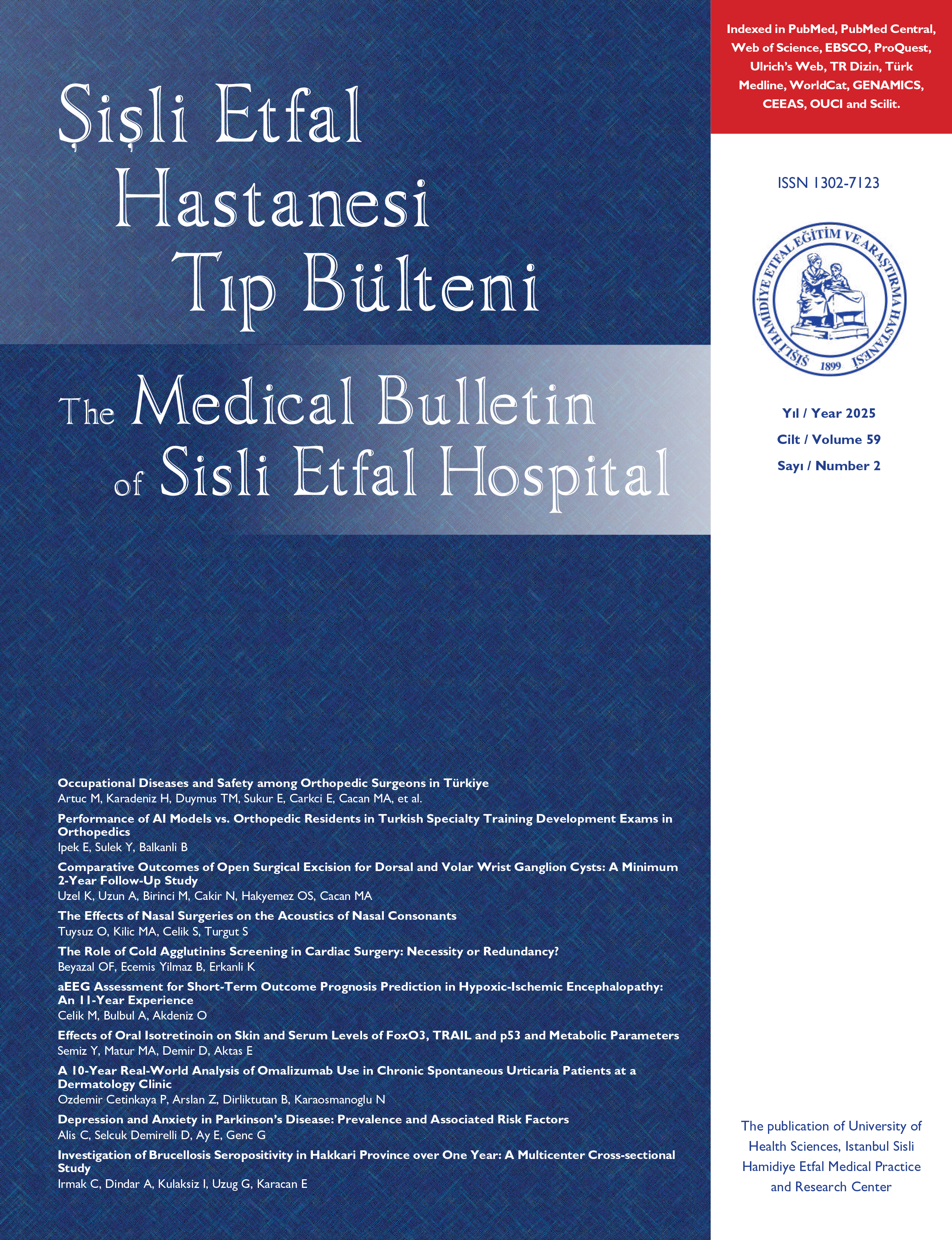
Sternum Detaşmanı Tamirinde Geleneksel veya Yenilikçi Yaklaşım: Robicsek veya Titanyum Plak
Yasin Ozden1, Safa Ozcelik1, Osman Murat Bastopcu1, Seyma Ozden2, Ugur Kisa1, Huseyin Kuplay11Türkiye Sağlık Bilimleri Üniversitesi, Dr Siyami Ersek Göğüs Kalp ve Damar Cerrahisi Eğitim ve Araştırma Hastanesi, Kalp Damar Cerrahisi Anabilim Dalı, İstanbul2Türkiye Sağlık Bilimleri Üniversitesi Süreyyapaşa Göğüs Hastalıkları ve Göğüs Cerrahisi Eğitim ve Araştırma Hastanesi, Göğüs Hastalıkları Anabilim Dalı, İmmünoloji ve Alerji Kliniği, İstanbul
Amaç: Sternotomi, kalp cerrahisinde halen en sık kullanılan insizyon yöntemidir. Sternal komplikasyonlar %0,5 ila %6,1 oranında görülür. Sternal detaşman, kalp cerrahisi sonrası morbidite ve mortaliteyi arttırır. Detaşmanı önlemek için alternatif sternum kapatma yöntemleri arayışları günümüzde de devam etmektedir. Bu amaçla üretilen titanyum plaklar, sternum detaşmanı nedeniyle reopere olan hastalarda da kullanılabilir. Çalışmamızda sternum detaşmanı nedeniyle reopere edilen hastalarda titanyum plak tamir yöntemi ile robicsek tamir yönteminin postoperatif sonuçlara etkisini araştırdık.
Yöntemler: Eylül 2013-Aralık 2020 tarihleri arasında hastanemizde sternal detaşman nedeniyle reoperasyon uygulanan ve preoperatif dönemde enfeksiyon bulgusu olmayan 34 hasta retrospektif olarak incelendi. Hastalar uygulanan cerrahi yönteme göre üç gruba ayrıldı. Bu gruplar; Grup 1: robicsek yöntemi kullanılan vakalar, Grup 2: titanyum plak yöntemi kullanılan vakalar, Grup 3: robicsek + titanyum plak yöntemlerinin bir arada kullanıldığı vakalar idi.
Bulgular: Temel demografik özellikler ve sternal detaşmana neden olan risk faktörleri açısından anlamlı fark olmayan hasta gruplarında mortalite ve hastanede kalış süresi açısından da anlamlı fark görülmedi. Postoperatif dönemde enfeksiyon oranlarına bakıldığında grup 1 ve grup 3'te sırasıyla %20 ve %21.4 postoperatif enfeksiyon tespit edilirken, sadece Robicsek tekniği ile tamir edilen grup 2'de postoperatif enfeksiyon %70 olarak gözlendi (p<0.05).
Sonuç: Literatürdeki çoğu çalışmanın desteklediği gibi titanyum plak uygulaması klasik tel serklaj yöntemine göre daha üstün bir sternum stabilizasyonu sağlamaktadır. Maliyet-etkililik açısından değerlendirildiğinde sternum detaşmanı açısından yüksek riskli hastalarda titanyum plak yöntemi uygulanabilir. (SETB-2022-04-087)
Anahtar Kelimeler: Kalp Cerrahisi, Robicsek, Sternal Dekolman, Sternal Detaşman, Titanyum Plak
Tradition or Innovation in Sternal Dehiscence Repair: Robicsek Versus Titanium Plate
Yasin Ozden1, Safa Ozcelik1, Osman Murat Bastopcu1, Seyma Ozden2, Ugur Kisa1, Huseyin Kuplay11Department of Cardiovascular Surgery, University of Health Sciences Türkiye, Dr Siyami Ersek Thoracic and Cardiovascular Surgery Training and Research Hospital, Istanbul, Türkiye2Department of Chest Diseases, Immunology and Allergy Clinic, University of Health Sciences Türkiye, Süreyyapaşa Chest Diseases and Thoracic Surgery Training and Research Hospital, Istanbul, Türkiye
Objectives: Sternotomy is still the most commonly used incision in cardiac surgery. Sternal complications are seen at a rate of 0.5% to 6.1%. Sternal dehiscence increases morbidity and mortality after cardiac surgery. To prevent dehiscence, the search for alternative sternum closure methods continues today. Titanium plates produced for this purpose can also be used in patients who are re-operated due to sternal dehiscence. In our study, we investigated the effects of titanium plate repair and robicsek repair on the results in patients who were reoperated due to sternal dehiscence.
Methods: Thirty-four patients who underwent reoperation due to sternal detachment in our hospital between September 2013 and December 2020 and had no signs of infection in the pre-operative period were analyzed retrospectively. The patients were divided into three groups according to the surgical method applied. These groups are as follows: Group 1: The cases in which the robicsek method was used, Group 2: the cases in which the titanium plate method was used, and Group 3: The cases where the robicsek + titanium plate methods were used together.
Results: There was no significant difference between the groups in terms of basic demographic characteristics and risk factors, leading to sternal dehiscence. There was no significant difference between the groups in terms of mortality and length of hospital stay. Considering the infection rates in the post-operative period, 20% and 21.4% post-operative infections were detected in Group 1 and Group 3, respectively, while 70% post-operative infection was observed in Group 2, which was repaired only with the Robicsek technique (p<0.05).
Conclusion: As supported by most studies in the literature, titanium plate application provides a superior sternum stabilization compared to the classical wire cerclage method. When evaluated in terms of cost-effectiveness, titanium plate method can be applied in high-risk patients in terms of sternal dehiscence.
Keywords: Cardiac surgery, Robicsek, sternal dehiscence, sternal detachment, titanium plate
Makale Dili: İngilizce



















